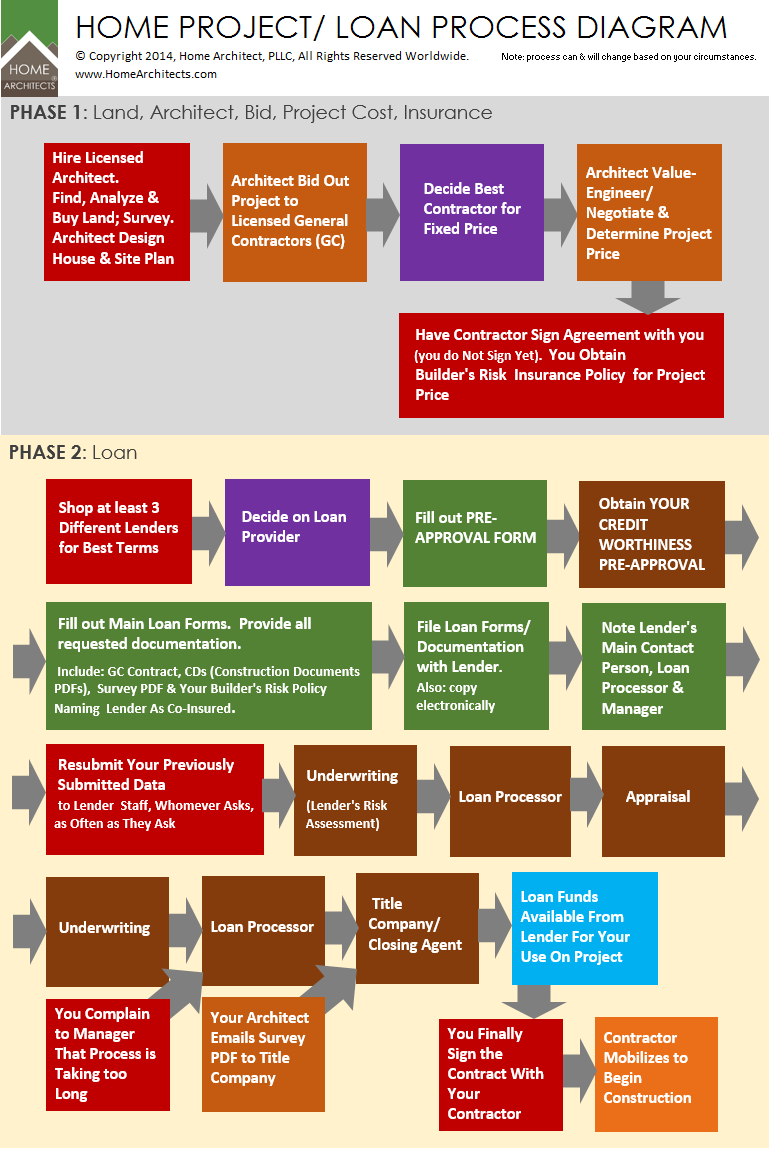Bank Loan Process is about what people just like you go through when you want to obtain a loan to build your house project, written by a leading custom residential Architect with decades of experience.
This online article tells you how long getting a house bank loan will likely take you, how to maintain your patience, bumps in the road you are likely to encounter, and how to be prepared for what will probably happen during the course of the procedure.
1. #1 THING TO KEEP IN MIND: PATIENCE: bank loan process:
This is going to try your patience. People who you think should be doing something important on your behalf either won’t, or will, in some way, leave you feeling let down and disappointed. Understand that you are likely going to have these emotional reactions. Knowing this; you need to control how you respond. Patience prevails. Do not let yourself slip and yell at someone who is trying to help you obtain hundreds of thousands of dollars (or more). Without banks and other lenders, we would all have to save up and use cash, so bless them. But we poke some fun at the process here (just a bit).
(continued below)
When people in service positions are screamed at, they drop your critical issues like a hot potato and take a vacation to Aruba, leaving your loan to dangle in the wind, or worse, to be assigned from the beginning (all over again) with yet another new loan person, who has no idea how long you’ve been waiting, doesn’t care about that, and can’t find anything about your loan, meaning that you’ll have to start from Square One. Again. So: be cool and professional at all times.
Bank Loan Process
2. FILL OUT YOUR PRE-APPROVAL APPLICATION FIRST: bank loan process:
At least 3 months before you think you’re going to need your money, ask your bank (or whatever lending source) for pre-approval forms regarding your creditworthiness. That can easily save you a month or more of time. They are going to want to know everything about you. If you want the loan and the money, tell them. Mainly, they want to know a few important things (and all the elements that support these foregone positive conclusions):
A. That you have a reliable income source (job, trust, whatever: it needs to be secure and long-term).
B. That you already have a large chunk of money (yeah: why would you need a loan if you have this? Well; you do. Banks don’t make loans to paupers).
C. Outstanding Credit Rating. Like 800+ if you want to impress the “Underwriter” (and you do want to do that).
D. Your intent to put down a sizable portion of your existing funds into the project, before you begin drawing on the bank loan funds. They want you to have more skin in the game than they do.
E. Own your land. They really don’t want to loan you 100% or feel like you don’t have anything to lose if you end up defaulting on your loan. You owning the property is usually one of the most important prerequisites.
F. That you seem like a decent human being that they can trust. They want you to be conservative in dress and manner and lifestyle. They want stability and level-headedness. Be soft-spoken, but speak clearly and simply. Don’t over-talk. Answer questions in a straightforward and confident way. Be positive, but not overly exuberant. Be friendly and nice, but not overly so. This is a business transaction. They trust middle-of-the-road personalities with dependability and predictability.
Starting to seem like you’re playing a part in a movie? You are! The reality show of your life! This is going to probably be one of the most important and highest-dollar transactions of your life. You want to understand and portray what it takes to get the loan.
3. TIME: bank loan process:
Some people will tell you 45 to 60 days to go through the whole bank loan process. The reality is: if you’re lucky it might. Including your preapproval, it may take you 3 months (sometimes longer). You’ll see why, later in this article. Is there any good reason why this should take this long? No. But it does (as you will see in this article, and discover for yourself while its happening to you).
4. TIME EXPANSION & BANK PERSONNEL: bank loan process:
This is one of the most bizarre things about the loan process. Things that you could do for yourself: like copying a form and setting it on a desk 10 feet away and then reading it, won’t take 10 minutes. Oh no. In a Bank, this could take 2 weeks. It happens all the time. Why? Because you aren’t the only person looking for a loan. There are stacks of applications, both physically and electronically waiting to be read and evaluated.
So: in case you think that you are special and “it’ll be alright”, NO IT WON’T. You have to get involved in this, to make sure everything goes right. More about this later.

You are going to need to have at least 2 Bank Champions in your corner, possibly 3. Why? Because they are busy people. When the people who are supposed to be getting things done don’t, you are going to need some managerial assistance to refocus people’s efforts on you and what you want. Why? Because the people working at the bank, particularly non-managerial staff, get a paycheck every week, regardless of whether you get your loan or not. Often times, they really may not care. Some may; others may not. However, managers are those who are supposed to get things in gear when they aren’t going as smoothly as they should. So: in addition to your main Bank contact, you should also know the Loan Processor person on a first-name basis with email and phone numbers, and also the Loan Processor’s Manager. That’s the cavalry that you call into play when things aren’t going right. Do not play that card too often, or you’ll just tick off every one and you’ll become a joke; a chronic complainer. Only do this when you have to: perhaps once or twice, during the entire process.
Now then, we have seen more than once, when ALL of your loan forms have been turned in to the Bank and everything seems to be going well and everything is quiet. THAT’s the time to get worried. If you aren’t hearing anything back, something like this might be about to happen:

“Hi, I’m Marlene.”
“Who?””Marlene Mondoh, from the Bank.”
“Annie Springer’s our Loan Processor. Who are you?”
“Ha-ha-ha. Well, Annie’s on vacation in Jamaica, so I’m handling your loan now.”
“(stunned silence on your part).”
“So, I can’t seem to find anything on your loan papers here. Hee-hee-hee. So, can you send me the RX-41 form, the B9-443, the 2245, the PreApproval Approved form, all the CDs, the Survey, a W-2 and a 3-year work history with your current employer?”
“We already sent all that stuff 4 weeks ago.”
“Oh. Okay. We can wait until Annie gets back next month; I’ve got some other files I need to get to…”
“No-no-no…I’ll send all that stuff to you again, if that’s what it takes. Here: just give me your email address and I’ll send you the PDFs for all of that right now.”
“Oh! You have all that electronically? Aren’t you prepared! Okay: send that to: MarlyGurl3622@8th12thBank.com.”
You have just successfully avoided a major disconnect for your loan processing at this point. Even if you are starting over with a new person, you have not lost any time in getting the correct information to the right new person. Many banks have a manager’s contact information at the bottom of loan processor email forms. Copy and take note of such a manager. Phone them. Now. Express your polite displeasure at your original Loan Processor leaving while your application was being processed and that you would appreciate the manager’s attention at this point to try to recover lost time and expedite the remainder of this effort. That manager will say “Certainly,” and immediately probably ignore your file. You, understanding this, will save your next call/email to that manager for later, when it is really necessary.
5. LOAN FORMS & ANCILLARY MATERIALS (such as insurance): bank loan process:
Your bank/lender is going to want to see a contract with your licensed building Contractor to build your house for a specific sum of money. For this reason, do not sign an agreement with a builder for a cost-plus arrangement; that will play hell with your loan and waste a lot of time for you.
You should have an Architect; he/she can help you get through the Bidding/Negotiation part of this with your Contractor(s) and also help your Bank and other entities to understand how much your house is going to be worth and why. For instance, your Bank is going to want to see your Builder’s Risk Insurance Policy (yeah: yours, not your Builder’s, and once again, your Architect can steer you straight on this). And, your Bank is going to want to see their institution named on the policy for a certain minimum amount (the loan amount at least). And the insurance company will want to hear from your Architect why your house is going to cost what it is. And, before you wonder about this fact: yes, YOU should be the main beneficiary (subject to your loan amount) on YOUR Builder’s Risk policy, because you actually own the house and land, while it is being built. You are paying your Builder and that act makes you the Owner, not him/her. So why would you want the Builder’s Risk policy to be in the Contractor’s name? You’ve ALREADY paid them (or will), before any unfortunate events occurred (such as lightning, theft, vandalism, fire, wind, earthquake, flood and other calamities). So: as the Owner, any insurance payments to rebuild your house should go to you. Yes, you will have to pay the Builder again to rebuild/repaid, but the insurance policy allows you to do that.

Your loan papers will also require a copy of the signed Owner-Contractor agreement. Be very careful here. You do Not want to give your Builder a copy of the agreement with your signature, until you obtain your loan. So: have your Architect help you with this. He/she can ask the Contractor to sign the agreement, then the Architect can furnish that to you, and you can sign it, but do NOT send that to the Builder. Yet. You can furnish that to the Bank, with your instructions to Not give or copy that to any other parties. After you get your loan, THEN send your mutually signed agreement to your Architect, who will then copy that to the Builder. The point being: you really don’t want to be on the hook to pay your Builder until you get your loan. Your Architect should understand this and help you administer this in your best interests.
Some of the information in your main loan form(s) will likely duplicate some of the information in your Pre-Approval Form. Understand that. Banks love redundancy. With the same answers. Provide all the information requested and leave no blanks. Say “N/A” where appropriate or what works in blanks where you have nothing to provide.
Now here’s where things start to get funny: MAKE SURE YOU HAVE ALL OF YOUR PRE-APPROVAL LOAN FORMS AND MAIN LOAN FORMS AND ALL INFORMATION RELATING TO YOUR LOAN AND HOUSE PRE-CONSTRUCTION BOTH ELECTRONICALLY AND HARDCOPY, COMPLETE WITH SIGNATURES IN HIGH RESOLUTION, HIGH QUALITY PDFs. Why? You ask. Well, guess what? This will Not be the only time that you have to provide this information to your lender (and for some of the information, to others). What? Why would that be? You ask again. Well, believe it or not, while it might seem like all lenders should have some wonderful, central electronic databank with every scrap of information you have ever provided to your Bank in that, this is not typically the case. And sometimes, you will find different people at the same Bank (possibly different branches, or the same one) asking multiple times for the same forms! And weeks later, after you sent all this information in to them! This is one of the most important revelations about the loan process. YOU have to be organized and prepared to resend the same information to possibly the same bank (likely to different people there) several times. You can politely tell anyone asking for these things again, that you did provide them on such and such a date, but that you would be happy to resend them again, now, via email. Always do as much as possible electronically. It will waste your time, gas and cost your patience doing everything hardcopy.
Keep a master file folder with separate files within it, each separate file in the folder identifying the various forms you will gather and create. However, ALSO DO THIS ELECTRONICALLY. As PDFs. That should yield the clearest, archival quality documents, no matter how often you send them.
You will probably need PDFs of your Construction Documents (CDs) from your Architect, including the Survey (that you have to have commissioned a long time ago, before your Architect got started). Your title company and Bank will want to see the Survey. Your Bank will want to see the CDs. Perhaps not all of them, but certainly a good chunk, so that they understand the project’s size, appearance, materials, systems, specifications and location on the land. Once again: your Architect can provide you with PDFs of these for your Bank and Title/Closing company.
6. UNDERWRITERS: bank loan process:

These are mystical people, dare we say: “demi-gods” at the Bank. These beings have no names and you will never be allowed to talk to one. They drift about in multi-colored silk robes, their feet never touching the floor. Only the high priestesses of the Bank are allowed to communicate with them, on certain sacred Pagan holidays. They float on air on clouds above the Banks they serve, with gossamer wings of silver & gold. They take your information and make a judgement call on whether or not you are good credit risk and if the loan information seems like a good thing for the Bank.
In reality, these people are Risk Managers, even though they are not called this. It is their job to not get blamed for meltdowns like happened in 2008-2010 during the USA’s Great Recession, from which we are just now starting to recover. In other words, these people really don’t want to approve anything, because doing so places them in jeopardy. They will be called on the carpet if you default and they approved your loan. It’s their neck on the chopping block if you screw up later. They have to be able to make an assessment on if you are a dependable person and if your finances and your project places the Bank in a position of conservative financial recoupment when and if you don’t pay in the future. No doubt they have developed, amongst their angelic cadre, analysis software that takes key pieces of information about you and your project, then munches and crunches you and your house data and spits out a number that has near-religious significance regarding a Go/No-go for you and your project. Your loan could be stagnating on an Underwriter’s desk for weeks. Their assessment is taken very seriously. You have no way of putting a tack on one of these beings’ chairs. Other than your Loan Processor’s Manager. But be careful how often you pull that rank on the unknown Underwriter. He/she/it will share with the Loan Manager some biblical/mystical saying like: “Yeah? You wanna approve this loan? I’ll get around to it when I’m good and ready…” Which could do you more harm than good.
Now then, guess what? Remember what happened to your Loan Processor? Well, the same thing can happen to “your” Underwriter. In other words, the guy or gal whose blessing you have to have to get your loan, just may take a vacation, or another job, right smack dab in the middle of your approval process. So, you may find yourself being asked from someone at the Bank (usually not a direct communication from the Underwriter, but from one of his/her/it’s High Priestesses) for all of your information AGAIN. Can you stand that? And not blow your top? Remember the advice to maintain both a hardcopy and a PDF emailable file? Here’s where that can save valuable time. Advice: whenever someone at the Bank asks for something, just send it to them again, no matter how many times you’ve sent it before. And don’t be surprised if they ask for something never asked before. Just do it: if you want the loan. Yes: they should have a central data bank and everyone should know where to find your information. Reality: this rarely happens and YOU become their data bank. Just give them the information. Expect it.
7. YOU ARE NOT IN CONTROL: bank loan process:
This really hacks off the triple A personalities. They think they can huff and puff and get thing done faster than the average person. Guess again. Remember the mystical realm of the sacred Underwriters? Dare you to tread on their silken robes, when your fate they hold close to their bosoms? Well, do you feel lucky? Hold your inclinations to poke, prod and yell. Be calm, matter of fact and businesslike. Only when you sense some egregious situation should you involve the Manager. Don’t become a pain in the backside. However, DO stand up for yourself when situations develop that will cost you money. Like the next one…
8. YOUR PRICE QUOTE FROM YOUR CONTRACTOR AND TIME: bank loan process:
Most Builders will only hold their guaranteed price for about a month. Some, perhaps 45 days to 60 days. Much beyond that, and you are going to be at their mercy. THIS IS WHY IT IS CRUCIAL TO HAVE EVERYTHING PRE-COMPLETED THAT YOU CAN WITH YOUR LENDER BEFORE YOU EVEN OBTAIN THE PRICE FROM THE BUILDER.
The second you have a specified “Deal”, or Contract with your Builder, that number will start to move upward if you exceed a certain time period. This is why you want to have your Bank/lender move things along as fast as possible. And why you want that Pre-Approval long before you fill out and send in the main loan papers to the Bank. That could make all the difference, and help get your loan commitment before your Contractor demands more to build your house.
By the way: this Contractor escalation of price is one of the main reasons why you do have the right to finally complain to the Loan Processor’s Manager, if time is being lost to any of the above reasons (or others). You can tell him/her that the Bank’s lack of efficiency is about to cost you umpteen thousand dollars in increased construction costs, for no reason other than the Bank is taking too long in processing your loan. And, if things don’t speed up soon, you are going to consider holding the Bank accountable for these increased costs. This is guaranteed to get the attention of the Manager, but don’t pull this too often. Technically, you have signed all sorts of papers with the Bank that probably absolves them of nearly anything, including time, taking your first born, and other things for which you might try to fault them down the road.
9. YOUR ARCHITECT: bank loan process:
While you might think all your Architect is good for is the design of your house, the Architect is the glue that can hold this entire loan process together. He/she is the professional that will be trusted to furnish the CDs (Construction Documents), copy of the Survey, vouch for construction cost information in the location of the project, distance from fire hydrants, fire districts, continue to hold the interest of your Builder and help keep you sane through all of this. Your Architect becomes your Answer-Person for anyone and everyone who wants to know about your proposed house. And because an Architect is a licensed professional, they have a major position of authority, like a Doctor, Lawyer, Engineer or Accountant.
10. APPRAISAL: bank loan process:
Your bank may have an in-house or 3rd party Appraiser. You may need your Architect to provide information about your intended house to justify the appraised amount. “Defective” appraisals happen. This is when the appraised amount doesn’t add up to as much or more than the amount of the loan for which you are asking. Of course, no lender is going to give you the money to build something that appears to be worth less than the amount of the loan they are giving you. If you default, they would like to be able to sell the asset for at least as much as the loan, so that their financial risk is mitigated (remember the Big Bust of 2008-2010?). Ask your Bank to please contact your Architect to receive detailed quality information about the house’s design and the value of other residences in the general area that might support that value through comparable listings and sales. And… did you notice? An appraisal can be deemed “defective.” Know what that means? It has to be done AGAIN. Once again, TIME expansion is what this means. It all adds up. So: Be ready and ask your Architect to be ready to furnish whatever information supports the Loan amount, the Insurance amount and other matters that the Appraiser needs to properly value the project.
Okay: do you have a better understanding of the Bank Loan Process now? Give the Architect a call if you need more information.
Bank Loan Process Architect: www.HomeArchitects.com Rand@HomeArchitects.com 828-269-9046
tags: bank loan process, Atlanta, Cashiers, Aspen, Telluride, Lake Toxaway, Highlands, Sapphire, Glenville, Hendersonville, Asheville, post and beam, hybrid, timber frame.

